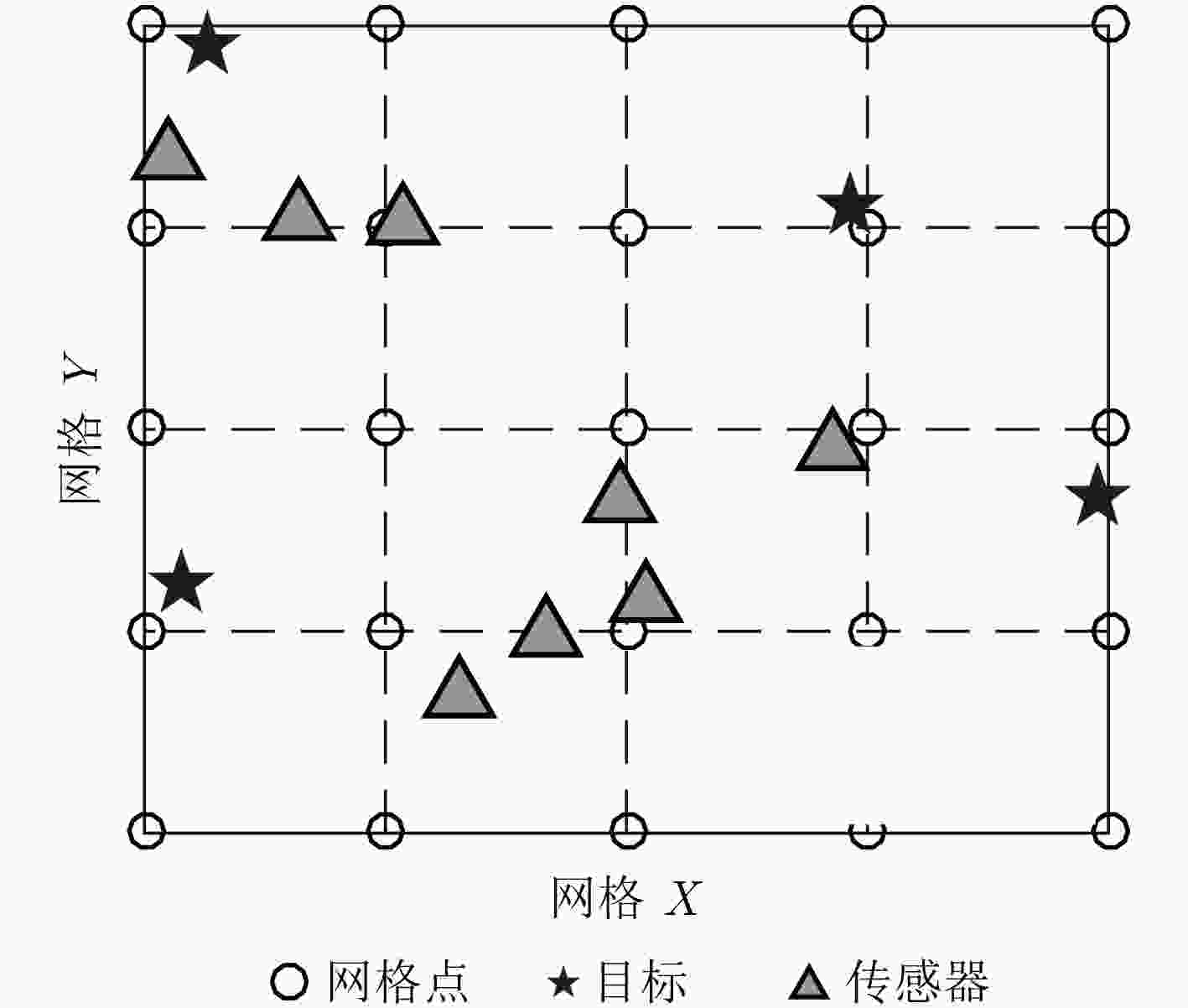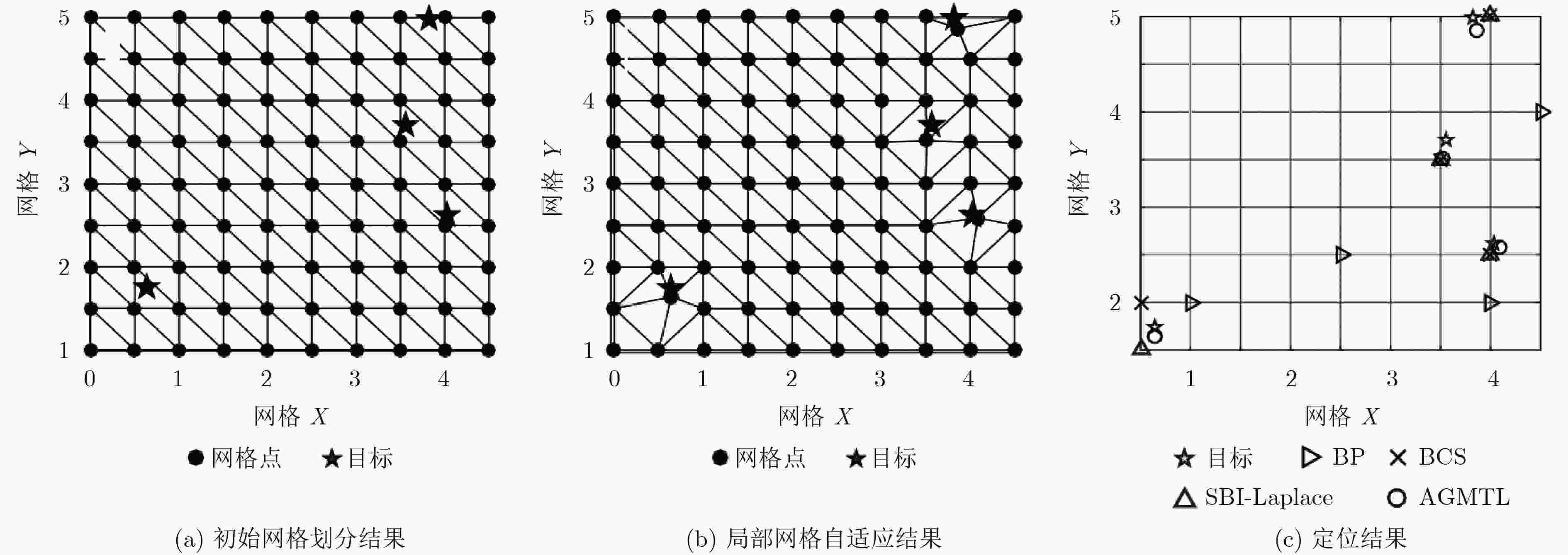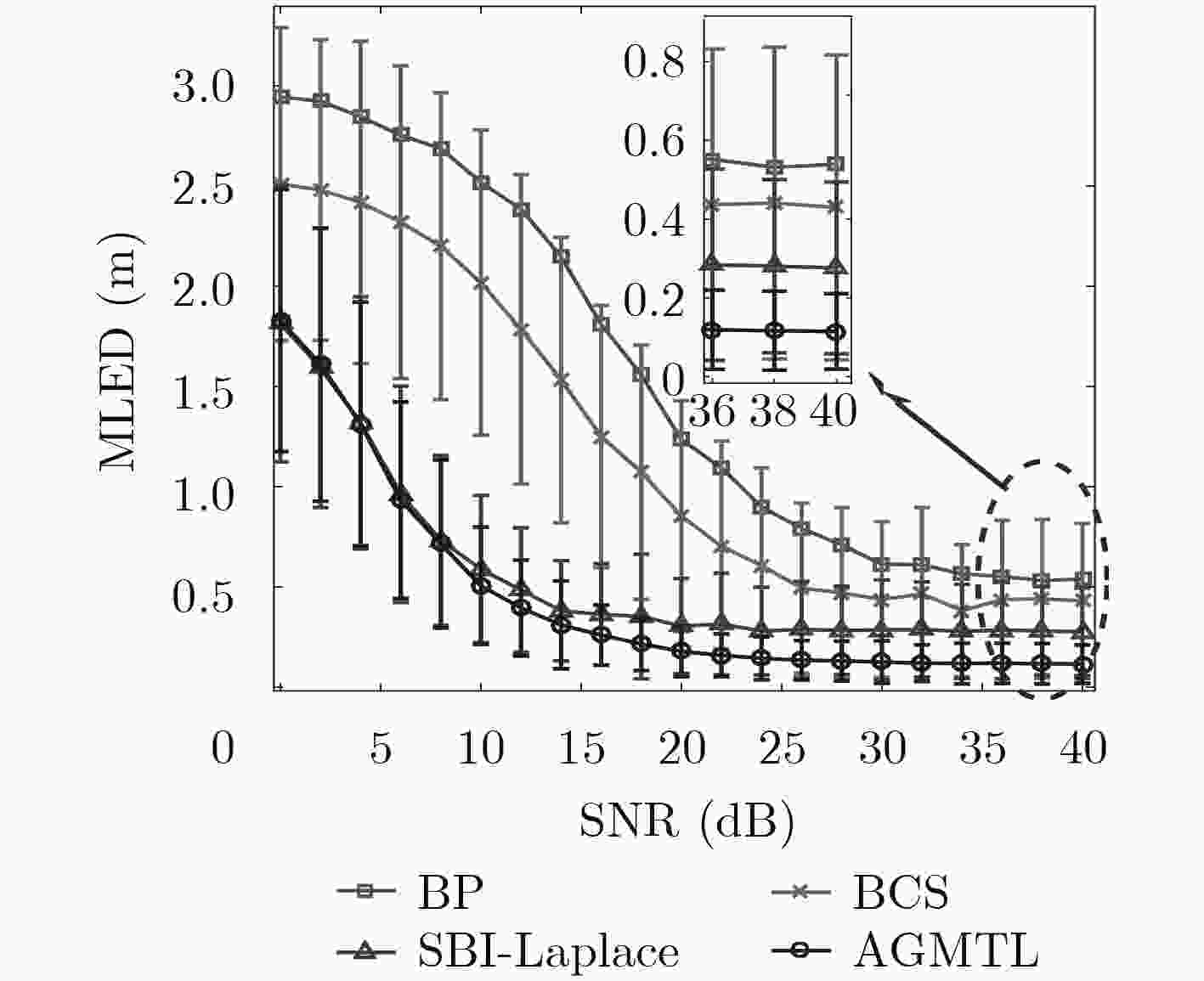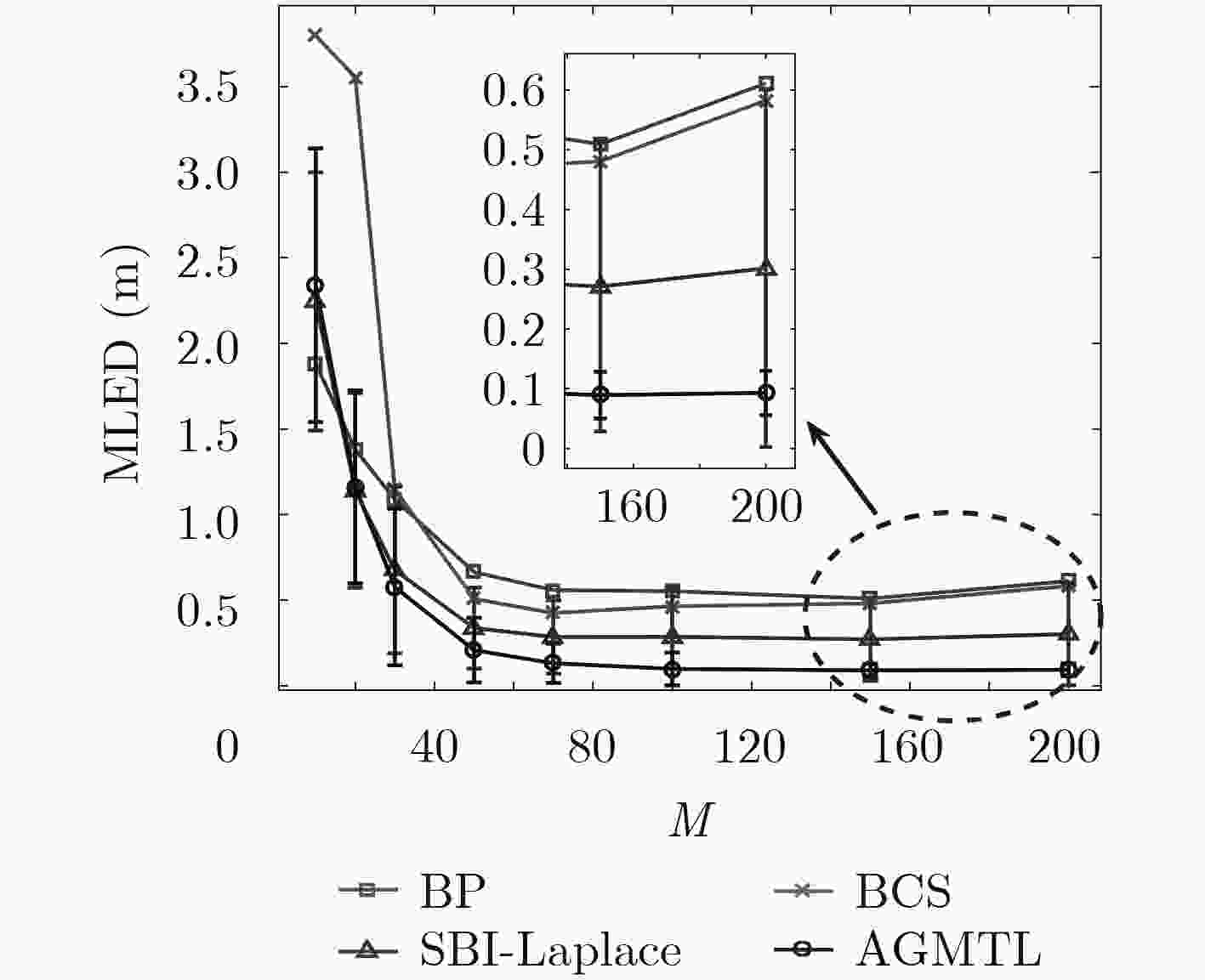Adaptive Grid Multiple Sources Localization Based on Sparse Bayesian Learning
-
摘要: 多源定位是信号处理中的重要问题。该文针对目标偏离初始网格点引起的基不匹配问题,构建具有Laplace先验的稀疏贝叶斯学习框架,提出基于稀疏贝叶斯学习的网格自适应多源定位算法AGMTL。本质上,AGMTL实现了稀疏信号重建和网格自适应定位字典的学习。仿真结果表明,AGMTL通过网格自适应调整,在定位误差,估计可靠性,抗噪性能上均远远优于传统的压缩感知定位算法。Abstract: Multiple sources localization is an issue of theoretical importance and practical significance in signal processing. The basis mismatch problem caused by target deviation from the initial grid point is addressed. Based on sparse Bayesian learning framework with Laplace prior, a novel iterative Adaptive Grid Multiple Targets Localization (AGMTL) algorithm is proposed to tackle the practical situation in which the targets deviates from the initial grid point. In essence, AGMTL algorithm implements sparse signal reconstruction and adaptive grid localization dictionary learning jointly. The simulation results show that AGMTL algorithm outperforms the traditional Compressive Sensing (CS) based localization algorithm in the terms of localization error, estimation reliability and noise robustness.
-
表 1 网格自适应多源定位算法
算法1:网格自适应多源定位 输入:测量结果矢量 ${{y}}$,初始网格点坐标集合 ${D_0}$,传感器坐标集合 ${P_s}$,传播模型 $f(d)$,目标个数 $K$; 输出:稀疏位置矢量 ${\hat{ {x}}}$,自适应网格坐标集合 $D$,目标位置集合 ${P_{{\rm{tgt}}}}$,目标功率集合 ${E_{{\rm{tgt}}}}$; 初始化:初始化超参数 ${{α}} $, $\beta $; ${{{θ}} _{{x}}} \leftarrow 0$, ${{{θ}} _{{y}}} \leftarrow 0$;由 ${D_0}$, ${P_s}$和 $f(d)$计算 ${{A}}$, ${{B}}$, ${{C}}$; 步骤1(字典逼近):依据式(5),由 ${{A}}$, ${{B}}$, ${{C}}$和 ${{θ}} $逼近定位字典 ${{Φ}} $; 步骤2(参数更新):由当前 ${{α}} $, $\beta $, ${{Φ}} $依次计算 ${{Σ}} $和 ${{μ}} $;依据式(20)和式(21),由当前 ${{α}} $, $\beta $, ${{Φ}} $, ${{Σ}} $和 ${{μ}} $更新 ${{α}} $和 $\beta $; 步骤3(网格自适应):依据式(30)和式(31),由当前 ${{α}} $, $\beta $, ${{Φ}} $, ${{Σ}} $, ${{A}}$, ${{B}}$, ${{C}}$学习网格偏移矢量 ${{{θ}} _{{x}}}$和 ${{{θ}} _{{y}}}$; 步骤4(迭代终止准则):计算残差能量 $\left\| {{{y}} - {{Φ}} {{x}}} \right\|_2^2$,若小于门限值或达到最大迭代次数,则终止迭代,输出参数;否则,继续迭代,跳转到步骤1; 步骤5(定位): ${\hat{ {x}}} \leftarrow {{μ}} $, $D \leftarrow {D_0} + [{{{θ}} _{{x}}},{{{θ}} _{{y}}}]$; ${P_{{\rm{tgt}}}} \leftarrow ${ ${\hat{ {x}}}$最大的前K个系数在D中的对应网格点位置}; ${E_{{\rm{tgt}}}} \leftarrow ${ ${\hat{ {x}}}$最大的前K个系数}。 -
GOLDONI E, SAVIOLI A, and RISI M. Experimental analysis of RSSI-based indoor localization with IEEE 802.15.4[C]. Wireless Conference, Lucca, Italy, 2010: 71–77. CAM L N, ORESTIS G, YUKI Y, et al. The wireless localization matching problem[J]. IEEE Internet of Things Journal, 2017, 4(5): 1312–1326 doi: 10.1109/JIOT.2017.2723013 LIN Xiaofei, YOU Kangyong, and GUO Wenbin. Delaunay triangulation and mesh grid combining algorithm for multiple targets localization using compressive sensing[C]. International Symposium on Wireless Personal Multimedia Communications, Shenzhen, China, 2017: 25–30. CANDES E J and WAKIN M B. An introduction to compressive sampling[J]. IEEE Signal Processing Magazine, 2008, 25(2): 21–30 doi: 10.1109/MSP.2007.914731 CEVHER V, DUARTE M F, and BARANIUK R G. Distributed target localization via spatial sparsity[C]. Signal Processing Conference, Lausanne, Switzerland, 2008: 1–5. FENG Chen, VALAEE S, and TAN Zhenhui. Multiple target localization using compressive sensing[C]. IEEE Global Telecommunications Conference, Honolulu, USA, 2009: 1–6. ZHANG Bowu, CHENG Xiuzhen, ZHANG Nan, et al. Sparse target counting and localization in sensor networks based on compressive sensing[C]. IEEE INFOCOM, Shanghai, China, 2011: 2255–2263. LAGUNAS E, SHARMA S K, CHATZINOTAS S, et al. Compressive sensing based target counting and localization exploiting joint sparsity[C]. IEEE International Conference on Acoustics, Speech and Signal Processing, Shanghai, China, 2016: 3231–3235. CHI Y, SCHARF LL, PEZESHKI A, et al. Sensitivity to basis mismatch in compressed sensing[J]. IEEE Transactions on Signal Processing, 2011, 59(5): 2182–2195 doi: 10.1109/TSP.2011.2112650 SUN Baoming, GUO Yan, LI Ning, et al. Multiple target counting and localization using variational Bayesian EM algorithm in wireless sensor networks[J]. IEEE Transactions on Communications, 2017, 65(7): 2985–2998 doi: 10.1109/TCOMM.2017.2695198 TIPPING M E. Sparse Bayesian learning and relevance vector machine[J]. Journal of Machine Learning Research, 2001, 1(3): 211–244 doi: 10.1162/15324430152748236 JI Shihao, XUE Ya, and CARIN L. Bayesian compressive sensing[J]. IEEE Transactions on Signal Processing, 2008, 56(6): 2346–2356 doi: 10.1109/TSP.2007.914345 TANG Gongguo, BHASKAR B N, SHAH P, et al. Compressive sensing off the grid[C]. Communication, Control, and Computing. Monticello, USA, 2013: 778–785. 陈栩杉, 张雄伟, 杨吉斌, 等. 如何解决基不匹配问题: 从原子范数到无网格压缩感知[J]. 自动化学报, 2016, 42(3): 335–346 doi: 10.16383/j.aas.2016.c150539CHENG Xushan, ZHANG Xiongwei, YANG Jibin, et al. How to overcome basis mismatch: From atomicnorm to gridless compressive sensing[J]. Acta Automatica Sinica, 2016, 42(3): 335–346 doi: 10.16383/j.aas.2016.c150539 CANDES E J and FERNANDEZ G C. Towards a mathematical theory of super-resolution[J]. Communications on Pure and Applied Mathematics, 2014, 67(6): 906–956 doi: 10.1002/cpa.21455 YANG Zai and XIE Lihua. Enhancing sparsity and resolution via reweighted atomic norm minimization[J]. IEEE Transactions on Signal Processing, 2016, 64(4): 995–1006 doi: 10.1109/TSP.2015.2493987 -






 下载:
下载:





 下载:
下载:
